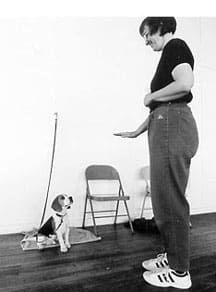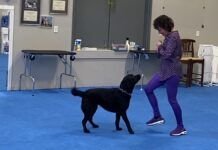Weddings always make me cry. I like to believe that’s because it touches the part of my heart that cherishes my own husband and our hard-won 15 years of marriage (so far!), but, knowing how hard it is to make relationships work and how easily they can fail, I wonder sometimes if at least a few of my tears are bittersweet. It’s human nature to predict the likely success or failure of a marriage, especially when a friend seems to have made an unwise choice of a life partner.
I often find myself mentally doing the same crystal ball exercise when a new client enters my training center with a seemingly mismatched canine companion. Sometimes I see right away that we are really going to have our work cut out for us. However, I really don’t ever despair; relationship miracles can, and do, happen. Seemingly misfit human/canine matches can grow into solid partnerships . . . as long as the partners have a few things going for them – the major components of a good relationship, the kind that’s built to last.
Different trainers may have other ideas, but the following are what I would consider required elements of a happy, ’til-death-do-us-part sort of relationship.

1: Trust
Just as with human partners, a dog/human relationship can’t thrive if either party lives in fear of the other. Dogs whose owners have reason to be afraid of them tend to have short life spans. If your dog scares you, seek immediate guidance from a positive trainer who has lots of experience, confidence, and success in dealing with aggressive dogs. (See “Once Bitten,” April 2002, for more information on aggression.)
If, however, your dog is fearful of you, it’s also unlikely that you will enjoy each others’ company very much, either in public or in your home. Training proceeds much more slowly when a dog is too scared to hear or understand your communications, to offer new behaviors, or even be near you.
If you have a fearful dog, you’ll have to work to earn his trust, through building a long history of positive interactions (which we’ll discuss). But you will also have to work hard to avoid damaging his developing trust; the use of force- or intimidation-based tactics is likely to make a cautious dog more frightened and quickly erase whatever progress you have made through your positive efforts.
2: High occurrence of positive reinforcement
John Gottman, Ph.D., a psychologist and professor in the Department of Psychology at the University of Washington in Seattle has studied marriage for the last 20 years. A pioneer in the use of videotape to monitor and then quantify various aspects of the human couples’ interactions, Dr. Gottman has identified relationship and communication factors that can predict – with 91 percent accuracy, he says – whether or not the couple will divorce.
According to Gottman, the most important predictor of long-term relationship success is the ratio of positive to negative interactions. If the ratio falls below 5 – 1 (five positive interactions to every one negative interaction) the marriage is bound to fail.
What does this have to do with dogs? Positive trainers, too, have found that dogs respond magnificently to training that utilizes a high rate of positive reinforcement. The more frequently you notice your dog’s good behaviors, and reward him with something he enjoys, the more frequently he will repeat those behaviors.
Remember, you have to be able to identify and make use of the things your dog likes or wants in order to truly “reward” or reinforce his good behavior. As we discussed in detail in “Just Rewards” (March 2002), patting a dog who does not like being patted is a punishment for him, rather than the kindly reward you may have intended it to be.
Positive trainers often rely on an abundant supply of extra-delicious food treats, because most dogs enjoy food. But anything the dog values can be used as a positive reinforcement for good behavior, thus creating another one of Dr. Gottman’s recommended “positive interactions.”
If you can figure out what your dog likes, control his access to these resources and then mete them out generously at appropriate times – when you want to reinforce good behavior or give him a more positive outlook on his surroundings – he will quickly learn to offer the behaviors you want more frequently. (For more information about how to put this principle into practice, see sidebar, “More on Motivation.”)
As an added bonus for doling out frequent rewards at appropriate times, your dog will associate you with all those good things, which will cause him to like being around you even more, pay more attention to you, and even anticipate your wishes – because that makes even more good stuff happen. Who doesn’t want that in a relationship?
3: Clear, frequent communication
I know that dogs can’t speak our language. What do I mean by communication?
When dogs receive unambiguous signals, and are consistently rewarded for correctly interpreting those signals and following through with the desired behavior, communication has clearly occurred. The more frequently this happens between dog and human, the better.

Jean Donaldson is an internationally known trainer, author of best-selling books The Culture Clash and Dogs Are From Neptune, and training director of the San Francisco SPCA. Donaldson once conducted a video study similar to Dr. Gottman’s study of human couples, only in her research, Donaldson turned the camera on trainers working with dogs, and dog owners training their own dogs. She found that, on average, trainers communicate with their canine pupils – either giving a cue or giving the dog a reinforcing marker and reward – more than three times as frequently as the average dog owner communicates with his or her dog.
Like children, co-workers, spouses, and (according to many reports) even houseplants, dogs do best with people who communicate with them. After all, they are pack animals with strong social instincts. They are most apt to respond to humans with whom they are familiar and comfortable, and whose communications they can understand.
4: Consistency
One of the most common behavior complaints of new Peaceable Paws clients (the human ones) is that their dogs jump up on them. Yet almost invariably I observe the new client telling her dog “Off!” (or worse, “Down”) one minute when he jumps up on her, and then mindlessly petting him for the exact same behavior the next minute. One of the most common behavior complaints of my new canine clients might well be their humans’ lack of consistency: “Well, darn it all, is it okay for me to jump up or not?!”
While it’s unfortunate that the owner’s inconsistency results in a poorly mannered dog who persists in jumping up because the behavior pays off frequently enough to make it worthwhile, the fallout is far worse than that. The lack of consistency that encourages the dog’s persistent jumping up (or any other unwanted behavior that is randomly reinforced) can cause serious damage to the relationship – on both sides.
The owner likes her dog less because of her perception that the dog doesn’t do what she says. Frustration rises, and she is more likely to resort to trust-damaging punishment-based techniques when the dog continues to “ignore” or “defy” her. The dog learns to look upon his irrational owner with mistrust and perhaps fear, maybe even becoming aggressive when the behavior that was rewarded yesterday is met today with anger and a hurtful knee in the chest.
On the other hand, consistent responses to a dog’s behaviors, both desirable and undesirable, are predictable for the dog, which helps him make sense of his world and feel safe. A dog whose world is orderly and safe is usually calmer, more relaxed, predictable, and better-behaved than one whose world is chaotic and intimidating. Dogs and owners who perceive each other as safe, predictable, and well-behaved, tend to enjoy a better mutual relationship.
5: Understanding of and accommodation to the dog’s personality, needs, and interests
Many people believe that some dogs are “eager to please.” In fact, all dogs are eager to please . . . themselves. It just so happens that some dogs enjoy doing the things that please us, giving rise to the pervasive misconception that they are turning themselves inside out to make us happy.
These mislabeled “eager-to-please” dogs are often the breeds that have been selectively bred for their ability to work closely with humans, such as the sporting, herding, and some of the working breeds. They tend to look to us for direction, which pleases us, and they generally enjoy praise and petting, which we tend naturally to offer as a reward for good behavior. What a happy fit!
Other breeds – terriers and hounds, for example – have been highly valued for their ability to work without close supervision – careening over hill and dale after foxes, raccoons, rabbits, and deer, or burrowing after varmints – all with a single-minded purpose that excludes the need for human direction or reinforcement. If anything, the presence of humans is often a hindrance to the mission, as those two-legged pack members have a bothersome habit of getting in the way and calling off the hunt just when things are getting exciting.
These dogs, like our two-year-old Scottish Terrier, Dubhy (prounounced Duffy), require more creativity and imagination to keep the training game fun, as we try to build relationship, willingness, and motivation to work – all in the quest for a well-mannered dog. It’s my job to work with and adapt to his interests and preferences if I want to end up with an enthusiastic training partner.
However, he constantly tests my positive training theories and creativity as I attempt, with varying degrees of success, to convince him that he wants to work with me – that fetching a ball, coming when called, or doing a down-stay is as much fun as harassing the blue-tailed skink that he has trapped in a crack between two boards of the back deck. But it would be unreasonable – and a recipe for failure – to expect him to adjust his interests in life to mine.
6: Ample quality time spent together in mutually enjoyable activities
My students often ask how much time they should spend each day training their dogs. My answer is a non-specific “the more, the better.” I remind them that any time they are with their dogs, one of them is training the other – and the more time the human is the trainer rather than the dog, the more successful the end relationship is likely to be.
Regardless of who is training whom in any given moment, for this time spent together to benefit the relationship, you and your dog have to do things together that you both think are swell. We prefer to be in the company of those with whom we have a relationship of mutual trust and respect, and especially those who consistently make good things happen when we are around them.
Dubhy is the first dog I have ever owned who prefers outdoors to indoors, perhaps because outdoors is where he thinks the best fun stuff happens. When we let the Miller pack out in the backyard to “do their business,” the other three quickly get the job done and cluster around the back door, waiting to come in. Not Dubhy. He’s out cruising the fence line, looking for lizards to harass or neighbor dogs to bark at, and is most reluctant to come in when called.
When I first realized his preference for the great outdoors, I just figured “Fine, he can stay out then.” This worked unless I really needed him to come in, and then the frustration of not being able to get him to come threatened to fray my patience and our relationship.
Eventually the training light bulb came on – for me. Dubhy was having more fun outside, by himself, than inside with me. Unless he really wanted to come in at that moment, it was much more exciting to stay outside. I started spending more time playing with him outside and more time doing fun things with him when I call him inside so he would be happier about coming in.
Our relationship saved, Dubhy and I still spend plenty of quality time together. Outside, I sometimes call him to me and turn over rocks and boards to help him look for lizards. (The lizards always get away.) We play “Find It!” where I have him lie down and wait while I hide liver treats and then release him to seek them out with his nose. When I do call him in we practice a few of his favorite tricks – a few minutes on his electronic keyboard, a rousing game of “Fetch the Jolly Ball,” or more “Find It!”
Now, when I am too busy writing to play training games with him, he curls up on the dog bed underneath my computer, smiling up at me with his impish Scottie eyes, happy to be in my company – for life!
Also With This Article
Click here to view “Building A Healthy Relationship With Your Dog”
Click here to view “Socializing With Your Dog Increases Socialization and Relationships”
Click here to view “Let’s Talk About Our Relationship”






